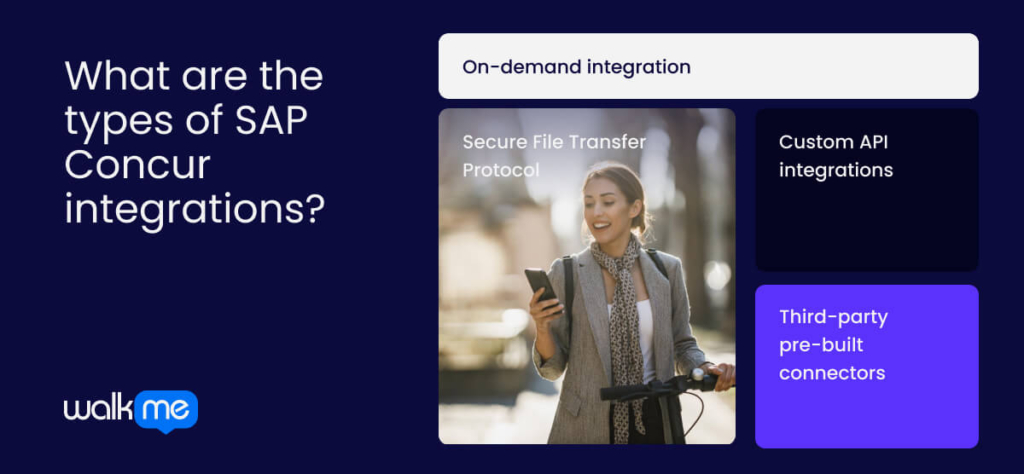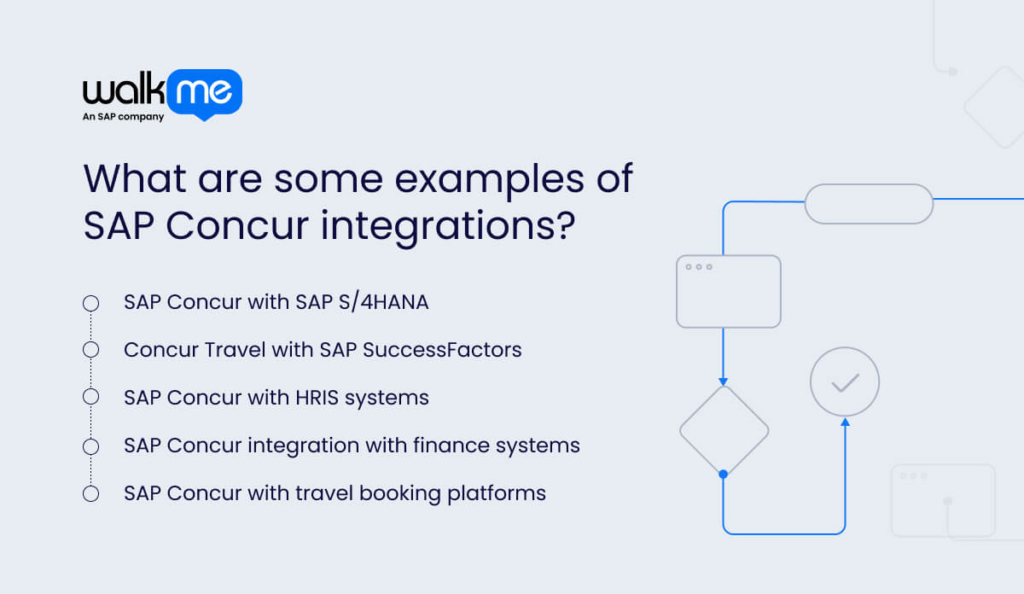System integration combines various systems and applications to create a seamless, interconnected digital workflow. Linking systems simplifies data sharing and ensures accuracy across the business.
An effective data integration setup allows information to move freely, regardless of which application is in use. Without integration, data may become outdated or trapped in silos, reducing its reliability.
SAP Concur integrations support this goal by connecting SAP Concur with systems such as ERP platforms, providing a unified view of spending data. This enhances accuracy, accelerates processes, and helps manage costs.
Built to scale, Concur integrations offer flexibility without requiring major technology overhauls.
This article explores what SAP Concur integrations are, why they matter, the different types available, and how organizations are using them effectively.
What are SAP Concur integrations?
SAP Concur integrations are an all-in-one system that connects tools like Concur Expense and Concur Travel with systems such as ERP, CRM, and accounting software. These integrations maintain data consistency by synchronizing employee and financial information across platforms.
Tasks such as approvals and transaction posting can also be automated, reducing manual effort and minimizing errors, both of which can boost employee morale. Automation ensures consistent application of company policies across systems, improving compliance.
Integrations provide better visibility into spending, which aids in informed decision-making. By reducing data entry and streamlining workflows, companies save time, lower costs, and enhance employee satisfaction while managing expenses more efficiently.
What is the purpose of SAP Concur integrations?
SAP Concur integrations offer a range of benefits that streamline operations and enhance both efficiency and user experience:
- Automate data transfers to reduce manual work and allow employees to focus on higher-value tasks.
- Enhance accuracy by eliminating duplicate data entry and ensuring consistent information across all systems.
- Provide a comprehensive view of spending, supporting better financial decision-making.
- Accelerate payments and reporting through real-time data synchronization.
- Enhance compliance by enforcing company policies and regulatory requirements.
- Improve the employee experience when booking travel and submitting expenses via connected systems.
What are the types of SAP Concur integrations?

SAP Concur integrations automate data sharing between systems, reduce manual work, and improve accuracy.
These are the types of SAP Concur integrations you can benefit from:
On-demand integration
On-demand SAP Concur integration enables users to connect Concur with other systems in a flexible and straightforward way. Instead of using full automation, users can access and update data directly within the Concur app.
This approach works well for companies that don’t have a large IT setup or require a quick and easy solution. It requires fewer technical skills and fewer resources than complex integrations. Users can control how and when they move data between systems.
This method also enables teams to manage changes independently, making the process more convenient and efficient.
Secure File Transfer Protocol
SFTP (Secure File Transfer Protocol) allows companies to securely transfer files between their systems and SAP Concur. It uses encryption through SSH to protect data, making it a safer option than regular FTP. Businesses often use SFTP to exchange flat files with accounting or ERP systems.
They can automate these transfers by setting schedules for importing and exporting data. Typical uses include automating user setup, tracking spending, and sending Standard Accounting Extract (SAE) files between Concur and other systems.
Custom API integrations
A custom API integration for SAP Concur connects Concur with other systems, such as ERP, payroll, or reporting tools, using tailored APIs to meet specific business needs. These integrations enable systems to exchange data seamlessly, thereby minimizing manual tasks. For instance, companies can use it for automated reporting, which helps save time and reduce errors.
Custom APIs also provide real-time insights into company spending, support compliance by ensuring accurate data transfers, and improve reporting by centralizing data. Every day use cases include linking Concur with ERP systems and payroll software.
Third-party pre-built connectors
Third-party pre-built connectors for SAP Concur make it easy for businesses to link Concur with other systems. These ready-made tools require little to no coding and are simple to set up. They help companies save time by using existing APIs and solutions, avoiding the need for custom development.
Companies can find many connectors in the SAP Concur App Center, covering a wide range of applications. These connectors ensure accurate and consistent data transfer between systems, facilitating seamless integration. They also automate tasks such as entering expenses, creating invoices, and processing payments, which improves workflows.
What are some examples of SAP Concur integrations?

Here are the examples of SAP Concur Integrations you will find helpful:
SAP Concur with SAP S/4HANA
Integrating SAP Concur with SAP S/4HANA helps businesses manage travel, expense, and invoice data more efficiently. This connection allows real-time insights, faster payments, and transparent financial reporting. It supports two-way data flow, allowing Concur documents to be imported and S/4HANA master data to be exported.
The system posts Concur data into S/4HANA, reducing manual work. Guided setup tools simplify the integration process. Users can also track document and payment status and use single sign-on for quick and secure access to Concur.
Concur Travel with SAP SuccessFactors
Integrating Concur Travel with SAP SuccessFactors synchronizes employee data—such as names, roles, and approval limits—into Concur for accurate travel booking and expense management. Employees book trips in accordance with company policies, and Concur Expense streamlines the process of submitting expense reports. While SuccessFactors doesn’t process reimbursements, expense data can be sent to SAP S/4HANA for financial handling and real-time spend visibility.
SAP Concur with HRIS systems
SAP Concur can connect with HR systems like Workday to make HR tasks easier and data more accurate. It automatically creates and updates user accounts based on HR data. Employee info, departments, and cost centers stay synced between Concur and the HR system. You can link expense reports automatically to third-party HR systems for easier tracking.
The integration ensures policy compliance and provides real-time visibility into expenses. SAP Concur offers pre-built connectors, custom API options, and third-party platforms for easy integration. For example, new hires get automatic Concur accounts, and HR can generate compliance reports quickly.
SAP Concur integration with finance systems
SAP Concur provides flexible integration options to connect with various financial systems, enhancing financial management. For instance, the Financial Integration Service (FIS) transfers data, such as expense reports and invoices, between Concur and finance systems.
It also confirms postings back to Concur, creating a closed process. Businesses can adopt APIs and connectors to link with third-party systems such as QuickBooks. These digital tools enable businesses to tailor integrations to meet their specific needs.
SAP Concur with travel booking platforms
SAP Concur lets employees book travel using its online tool or other platforms. Concur TripLink tracks trips booked outside of Concur, providing companies with access to negotiated rates and other benefits. It manages travel plans and expense reports for all trips, no matter where employees book. The Concur mobile app helps users book trips, capture receipts, and submit expenses on the go.
Aligning SAP Concur integrations with enterprise IT goals
Successful SAP Concur integration requires more than a technical setup. It depends on solid planning and a long-term approach. Use modular, reusable components to simplify updates and maintenance. Establish clear documentation and data governance to ensure consistency and accuracy.
As the organization scales and SAP Concur changes, plan for system updates and evolving requirements. Define roles for integration support to maintain reliability. Align integration work with IT and finance strategies to maximize value.
FAQs
SAP Concur integrates with SAP systems, such as SAP ECC and SAP S/4HANA, through two editions: Standard and Professional. The Standard Edition supports basic integration for simple needs, while the Professional Edition offers more advanced features, custom options, and broader ERP connectivity.
SAP Concur integrations enable companies to manage spending more easily and effectively. They connect different systems to automate tasks, reduce errors, and provide real-time spending insights. This leads to improved efficiency, lower costs, and more informed decisions.
Integrating SAP Concur can come with some challenges. These include aligning with company policies, integrating with ERP or accounting systems, utilizing automation tools, maximizing data utilization, and providing users with the necessary training and support.

